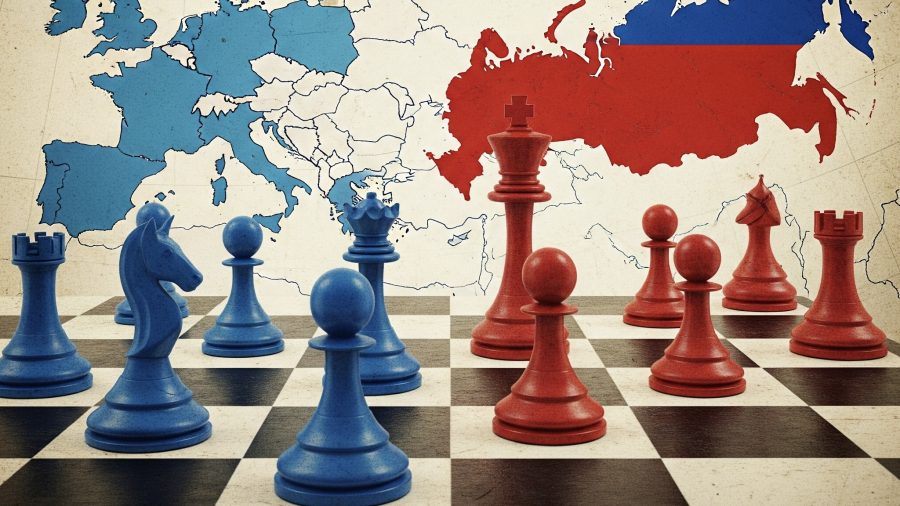Andrew Michta’s Helsinki-Commission briefing, available on YouTube and social media, urges Europe to accelerate the deployment of armour and air-defence to its eastern flank. His logistics are solid, yet the argument remains trapped in a materialist mindset. The Kremlin’s strategic theatre is part gun-count, part morality play; it must perform the role of a besieged civilisation to sustain elite cohesion and domestic consent (Giles, 2021). Moscow therefore magnifies even token NATO deployments, weaving them into a narrative of encirclement. Numbers certainly matter, but myths and interpretations drive policy.
Historically, Western analysis rarely pauses on this critical identity driver. Civilisational framings, or what Marlene Laruelle calls Russia’s “anti-liberal European” self-image (Laruelle, 2016), explain why deterrence sometimes falters when, on balance, an alliance should be the rational option. Michta’s focus on equipment and troop-tallies risks underestimating this discursive asymmetry.
NATO’s dilemma: choreographing presence
The security dilemma cannot just be wished away, but its social meaning can be reframed. NATO now plans to defend forward with rotating brigades rather than permanent garrisons. Visibility is deliberate: forces spend most of their time at home and surge only for exercises, reassuring Baltic publics while limiting imagery that feeds Moscow’s siege myth. Twenty-two Allies already meet the 2 per cent GDP benchmark, up from three a decade ago (NATO, 2024), yet credible posture still requires narrative discipline. Radical transparency, such as publishing force-flow schedules and live-streaming major drills, signals defensive intent and denies the Kremlin the fog in which worst-case fantasies multiply. A minimalist inspection regime, of the kind sketched in recent European Leadership Network workshops, could complement this by addressing Russian ontological insecurity without conceding capability (ELN, 2024).
Lessons from outside Europe
Wargames on a Taiwan contingency reinforce the logic. RAND analysts find that smart sea-mines, road-mobile fires and cheap drones raise the PLA’s operational risk more sharply than prestige carriers (RAND, 2023). Denial assets lower the escalatory temperature while still signalling resolve. Yet capability is not enough: Beijing will test whether the coalition’s political will is socially durable. Expanding informal constructs like AUKUS into routine crisis-response exercises needs to narrate a shared story of status-quo preservation rather than anti-China containment.
South Asia offers a counter-example. The 2025 India-Pakistan crisis, analysed at the Belfer Center, showed deterrence only holding once both sides satisfied domestic identity needs with symbolic strikes before back-channeling de-escalation (Belfer, 2025). Conversely, the Israel–Hezbollah dyad illustrates erosion: CSIS charts a steep rise in rocket exchanges as mutually reinforcing victim narratives demand ever larger demonstrations of “honour” (CSIS, 2024). Deterrence frays when stories that cultures tell themselves are left unmanaged.
Policy implication
Europe’s re-armament is necessary, but insufficient by itself. Credible high-readiness forces must be paired with an information architecture that denies Moscow the dramaturgy it craves. That means choreographed deployments, radical transparency, selective arms-control gestures and a public narrative that casts NATO as guardian of a plural security order, not the shadow of tomorrow’s invasion. Any deterrence strategy that ignores identity politics may well become an expensive repeat of history.
Bibliography
Belfer Center (2025) Escalation Gone Meta: Strategic Lessons from the 2025 India–Pakistan Crisis. Harvard Kennedy School.
CSIS (2024) The Coming Conflict with Hezbollah. Center for Strategic and International Studies.
European Leadership Network (2024) OSCE Workshop Report: Strengthening European Security Architecture.
Giles, K. (2021) What Deters Russia. Chatham House.
Laruelle, M. (2016) ‘Russia as an Anti-liberal European Civilisation’, in The New Russian Nationalism, Edinburgh University Press.
Michta, A. (2024) ‘Why NATO Must Step Up’, testimony to the U.S. Helsinki Commission.
NATO (2024) ‘Defence Expenditures and the 2 Per Cent Guideline’.
RAND Corporation (2023) These Technologies Could Defeat China’s Missile Barrage and Defend Taiwan.

